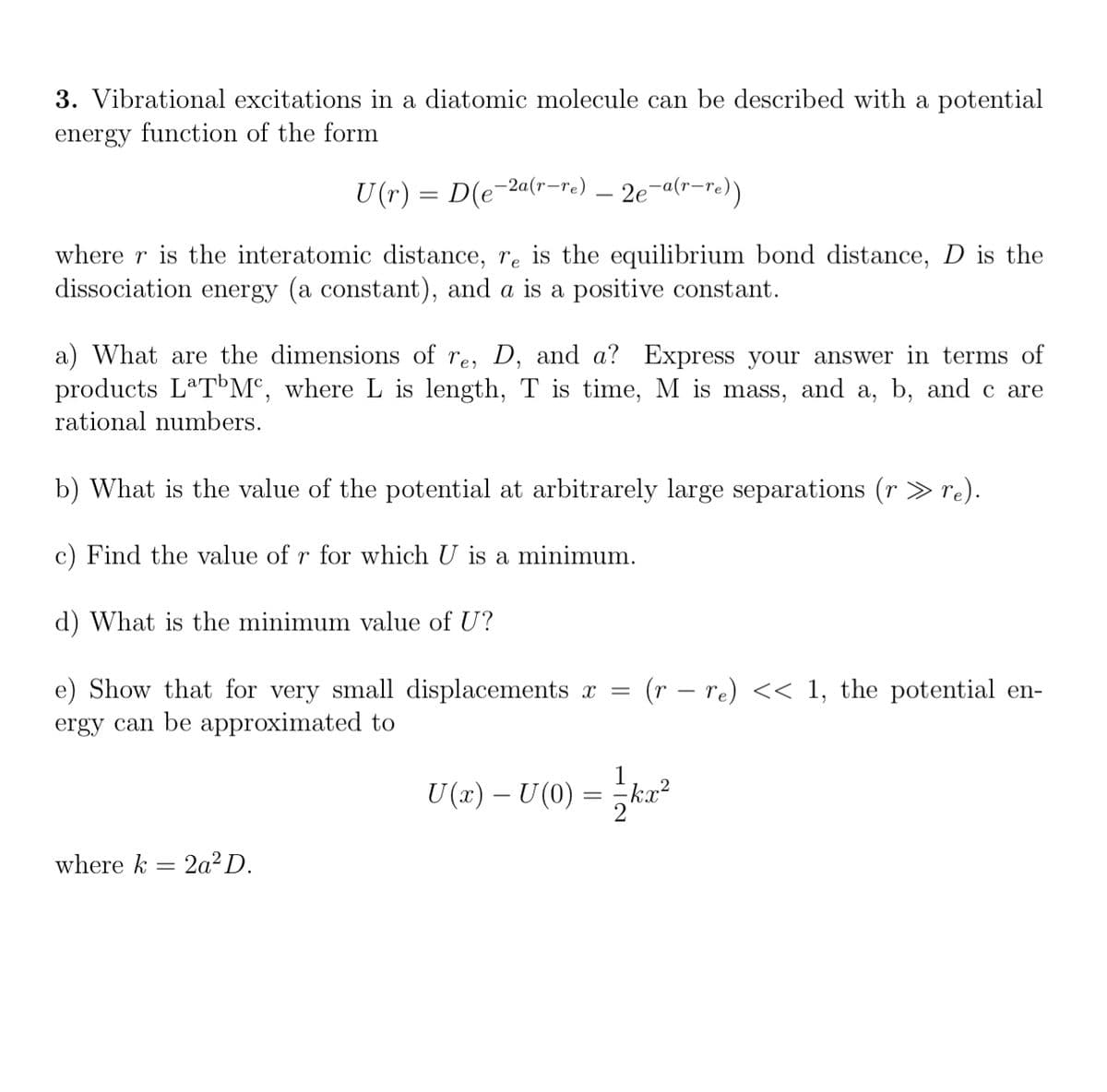3. Vibrational excitations in a diatomic molecule can be described with a potential energy function of the form U(r) = D(e-2a(r-re) – 2e¬a(r-re)) %3D where r is the interatomic distance, re is the equilibrium bond distance, D is the dissociation energy (a constant), and a is a positive constant.
3. Vibrational excitations in a diatomic molecule can be described with a potential energy function of the form U(r) = D(e-2a(r-re) – 2e¬a(r-re)) %3D where r is the interatomic distance, re is the equilibrium bond distance, D is the dissociation energy (a constant), and a is a positive constant.
Physics for Scientists and Engineers with Modern Physics
10th Edition
ISBN:9781337553292
Author:Raymond A. Serway, John W. Jewett
Publisher:Raymond A. Serway, John W. Jewett
Chapter42: Molecules And Solids
Section: Chapter Questions
Problem 6P: The photon frequency that would be absorbed by the NO molecule in a transition from vibration state...
Related questions
Question
Please do it step by step because I really want to understand the HW??

Transcribed Image Text:3. Vibrational excitations in a diatomic molecule can be described with a potential
energy function of the form
U (r) = D(e-2a(r-re) – 2e¬a(r-re))
where r is the interatomic distance, re is the equilibrium bond distance, D is the
dissociation energy (a constant), and a is a positive constant.
a) What are the dimensions of re, D, and a? Express your answer in terms of
products LªT'M°, where L is length, T is time, M is mass, and a, b, and c are
rational numbers.
b) What is the value of the potential at arbitrarely large separations (r > re).
c) Find the value of r for which U is a minimum.
d) What is the minimum value of U?
e) Show that for very small displacements x =
ergy can be approximated to
(r – re) << 1, the potential en-
U (x) – U (0)
ka
where k
2a? D.
Expert Solution
This question has been solved!
Explore an expertly crafted, step-by-step solution for a thorough understanding of key concepts.
This is a popular solution!
Trending now
This is a popular solution!
Step by step
Solved in 4 steps with 4 images

Recommended textbooks for you

Physics for Scientists and Engineers with Modern …
Physics
ISBN:
9781337553292
Author:
Raymond A. Serway, John W. Jewett
Publisher:
Cengage Learning

Modern Physics
Physics
ISBN:
9781111794378
Author:
Raymond A. Serway, Clement J. Moses, Curt A. Moyer
Publisher:
Cengage Learning

University Physics Volume 3
Physics
ISBN:
9781938168185
Author:
William Moebs, Jeff Sanny
Publisher:
OpenStax

Physics for Scientists and Engineers with Modern …
Physics
ISBN:
9781337553292
Author:
Raymond A. Serway, John W. Jewett
Publisher:
Cengage Learning

Modern Physics
Physics
ISBN:
9781111794378
Author:
Raymond A. Serway, Clement J. Moses, Curt A. Moyer
Publisher:
Cengage Learning

University Physics Volume 3
Physics
ISBN:
9781938168185
Author:
William Moebs, Jeff Sanny
Publisher:
OpenStax